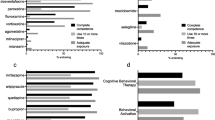Abstract
Treatment resistant mood disorders (TRMD) have a significant impact on patients and society. Electroconvulsive therapy (ECT) has been shown to be effective for treatment resistant depression (TRD). Despite the effectiveness and safety of ECT, there remains significant stigma surrounding its use. Studies worldwide have shown that many medical students receive their knowledge from the media, which often portrays ECT in a negative light, and very few have exposure to ECT prior to their psychiatric clinical rotations. In this article we highlight the importance of medical education and introduce a novel approach in helping to fight the stigma of ECT through educational intervention for medical trainees that combines active, longitudinal and theoretical learning. By ensuring that trainees have a robust education in this arena, we can help them educate patients about treatment options, improve confidence in prescribing and administering these therapies, and ultimately improve patient and societal outcomes.


Similar content being viewed by others
References
WHO. Depression and Other Mental Health Disorders: Global Health Estimates. 2017. [Accessed 2 Apr 2018]. https://apps.who.int/iris/bitstream/handle/10665/254610/WHO-MSD-MER-2017.2-eng.pdf;jsessionid=925364EEBC1750B430544CBCF683D571?sequence=1
Rush AJ, Trivedi MH, Wisniewski SR, Nierenberg AA, Stewart JW, Warden D, Niederehe G, Thase ME, Lavori PW, Lebowitz BD, et al. Acute and longer-term outcomes in depressed outpatients requiring one or several treatment steps: a STAR*D report. Am J Psychiatry. 2006;163(11):1905–17.
McIntyre RS, Filteau M-J, Martin L, Patry S, Carvalho A, Cha DS, Barakat M, Miguelez M. Treatment-resistant depression: definitions, review of the evidence, and algorithmic approach. J Affect Disord. 2014;156:1–7.
Ivanova JI, Birnbaum HG, Kidolezi Y, Subramanian G, Khan SA, Stensland MD. Direct and indirect costs of employees with treatment-resistant and non-treatment-resistant major depressive disorder. Curr Med Res Opin. 2010;26(10):2475–84.
Johnston KM, Powell LC, Anderson IM, Szabo S, Cline S. The burden of treatment-resistant depression: A systematic review of the economic and quality of life literature. J Affect Disord. 2019;242:195–210.
UK Ect Review Group. Efficacy and safety of electroconvulsive therapy in depressive disorders: a systematic review and meta-analysis. Lancet. 2003;361(9360):799–808.
Husain MM, Rush AJ, Fink M, Knapp R, Petrides G, Rummans T, Biggs MM, O’Connor K, Rasmussen K, Litle M, et al. Speed of response and remission in major depressive disorder with acute electroconvulsive therapy (ECT): a Consortium for Research in ECT (CORE) report. J Clin Psychiatry. 2004;65(4):485–91.
Kellner CH, Greenberg RM, Murrough JW, Bryson EO, Briggs MC, Pasculli RM. ECT in treatment-resistant depression. Am J Psychiatry. 2012;169(12):1238–44.
Tørring N, Sanghani SN, Petrides G, Kellner CH, Østergaard SD. The mortality rate of electroconvulsive therapy: a systematic review and pooled analysis. Acta Psychiatr Scand. 2017;135(5):388–97.
Walter G, McDonald A, Rey JM, Rosen A. Medical student knowledge and attitudes regarding ECT prior to and after viewing ECT scenes from movies. J ECT. 2002;18(1):43–6.
American Psychiatric Association. The practice of electroconvulsive therapy: recommendations for treatment, training, and privileging (A task force report of the American Psychiatric Association). [place unknown]: American Psychiatric Pub. 2008.
Gazdag G, Sebestyén G, Ungvari GS, Tolna J. Impact on psychiatric interns of watching live electroconvulsive treatment. Acad Psychiatry. 2009;33(2):152–6.
Pranjkovic T, Degmecic D, Medic Flajsman A, Gazdag G, Ungvari GS, Kuzman MR. Observing electroconvulsive therapy changes students’ attitudes: a survey of Croatian medical students. J ECT. 2017;33(1):26–9.
Ithman M, O’Connell C, Ogunleye A, Lee S, Chamberlain B, Ramalingam A. Pre- and post-clerkship knowledge, perceptions, and acceptability of electroconvulsive therapy (ECT) in 3rd year medical students. Psychiatry Q. 2018;89(4):869–80.
National Academy of Engineering, National Academy of Sciences, Policy and Global Affairs, Institute of Medicine, Committee on Science, Engineering, and Public Policy. Adviser, teacher, role model, friend: On being a mentor to students in science and engineering. [place unknown]: National Academies Press. 1997.
Balhara Y, Yadav T, Mathur S, Kataria D. The impact of A “Brief ECT Orientation Module” on the knowledge and attitudes of medical students towards ECT in India. Ann Med Health Sci Res. 2012;2(2):140–5.
Trenton A, Pelchat R. Medical students’ perceptions of electroconvulsive therapy: the impact of direct exposure. J ECT. 2016;32(1):20–2.
Solomon S, Simiyon M, Vedachalam A. Effectiveness of an educational intervention on medical students’ knowledge about and attitude towards electroconvulsive therapy. Acad Psychiatry. 2016;40(2):295–8.
Raysin A, Gillett B, Carmody J, Goel N, McAfee S, Jacob T. From information to simulation: improving competency in ECT training using high-fidelity simulation. Acad Psychiatry. 2018;42(5):653–8.
Scott G, Semple DM. Survey of core trainees’ confidence in electroconvulsive therapy. J ECT. 2018;34(2):113–6.
Funding
There were no funding sources for this project.
Author information
Authors and Affiliations
Corresponding author
Ethics declarations
This Educational Case Report was written to describe a curriculum and was not designed to be a research study. The authors consulted with the UTHealth Institutional Review Board on this project. It was determined that this project did not meet human subjects research criteria and did not need to undergo an IRB approval process.
Conflict of Interest
On behalf of all authors, the corresponding author states that there are no conflicts of interest.
Additional information
Publisher's Note
Springer Nature remains neutral with regard to jurisdictional claims in published maps and institutional affiliations.
Rights and permissions
About this article
Cite this article
Yau, B.N., Rong, C., Findley, J.C. et al. A Novel Refractory Mood Disorders and Electroconvulsive Therapy Elective for Medical Students: Fighting Stigma through Experience. Psychiatr Q 92, 1541–1548 (2021). https://doi.org/10.1007/s11126-021-09929-4
Accepted:
Published:
Issue Date:
DOI: https://doi.org/10.1007/s11126-021-09929-4




